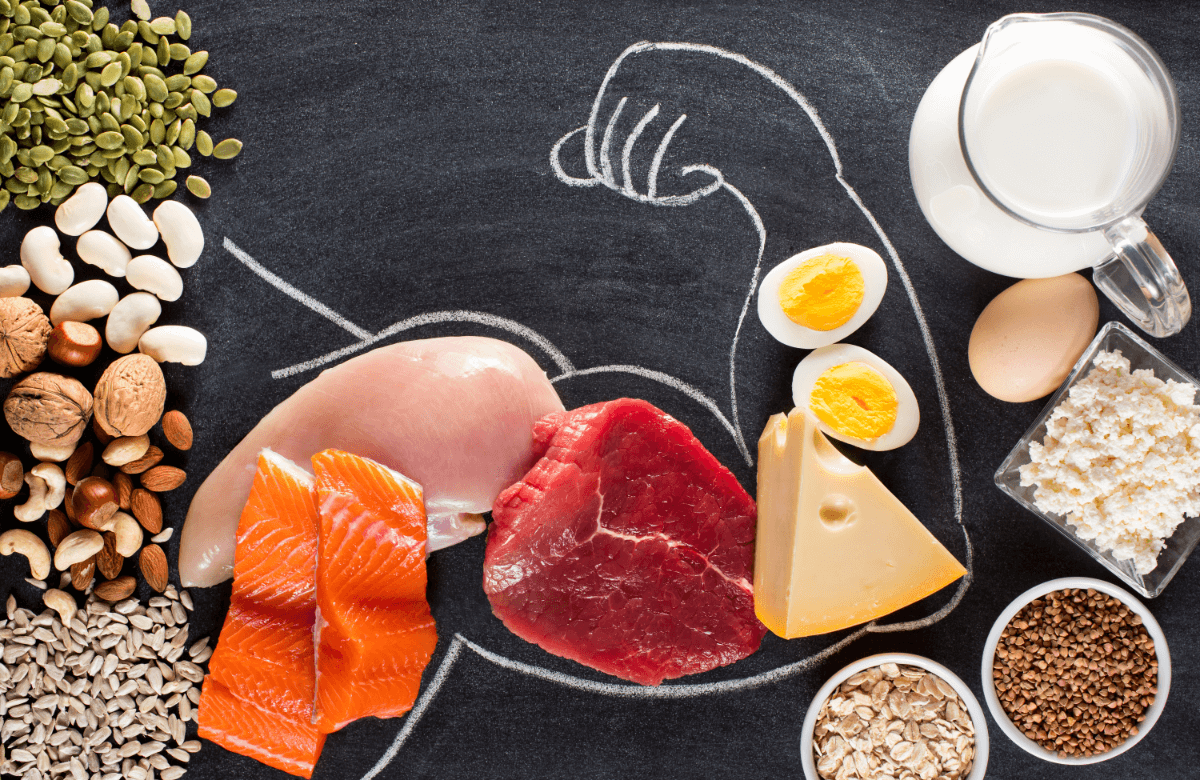What are the top three things you need to know about high-protein diets? The answer is what to eat, the benefits of eating more protein, and how much protein you need. We are going to discuss these topics in this article. We will also provide you with 20 quick high protein meals that will keep you full for hours.
Jump to:
- The 20 Best High Protein Meals
- 1. Creamy Tuscan Chicken
- 2. Salmon Risotto
- 3. Greek Yogurt Chia Pudding
- 4. Roasted Pumpkin Seeds
- 5. Scrambled Eggs With Fresh Veggies
- 6. Salmon with Broccoli and Carrots
- 7. Mongolian Beef With Garlic Sauce
- 8. Anchovy Pizza
- 9. Cottage Cheese Bowls
- 10. Irish Stew
- 11. Asian Crispy Soy Garlic Tofu
- 12. Curried Tempeh Salad
- 13. Sardines
- 14. Frittata
- 15. Grilled Chicken Breast
- 16. Seasoned Grilled Fish
- 17. Lean Beef Cheeseburger
- 18. Lentils
- 19. Blueberry Protein Pancakes With Caramel Sauce
- 20. Creamy Garlic Seafood Pasta
- What Is a High-Protein Meal?
- Benefits of High Protein Meals
- High Protein Foods
- Concerns About High-Protein Diets
- How Much Protein an Adult Should Consume Daily
- When Is the Best Time to Consume Protein?
- How Many Times a Week You Should Meal Prep
- Our 10 Tips for Successful Meal Prepping
- High-Protein Meals: FAQs
The 20 Best High Protein Meals
Here are our 20 easy high protein meals you can make in 20 minutes.
1. Creamy Tuscan Chicken

Chicken and any type of poultry is probably the protein most people are using. Chicken tends to be more lean than other type of meat. It is going to be a little bit higher in protein and a little bit lower in fat. If you struggle with satiety, you might want to cook your chicken in a little bit extra of butter or olive oil or pair it with avocado.
About three ounces of cooked chicken thigh will have around 27 grams of protein so it is pretty packed with protein and also has a high DIAAS score.
2. Salmon Risotto
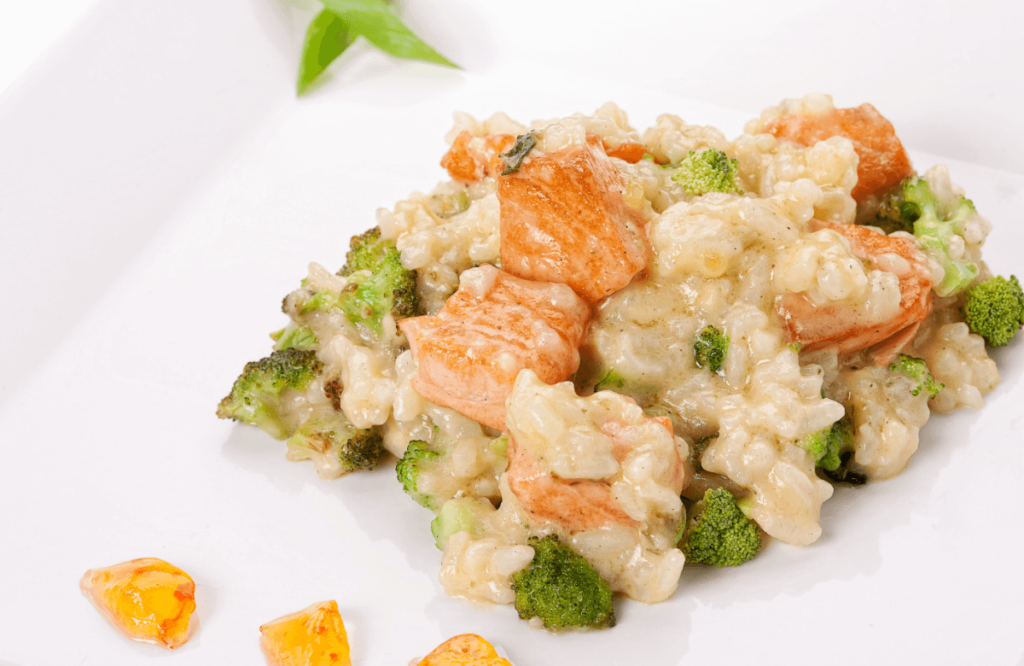
Salmon is rich in selenium which is required for Phase 2 liver detoxification. Not only do you get a lot of protein with just a bit of salmon, but you also get a lot of selenium and anti-inflammatory Omega-3 fats.
3. Greek Yogurt Chia Pudding
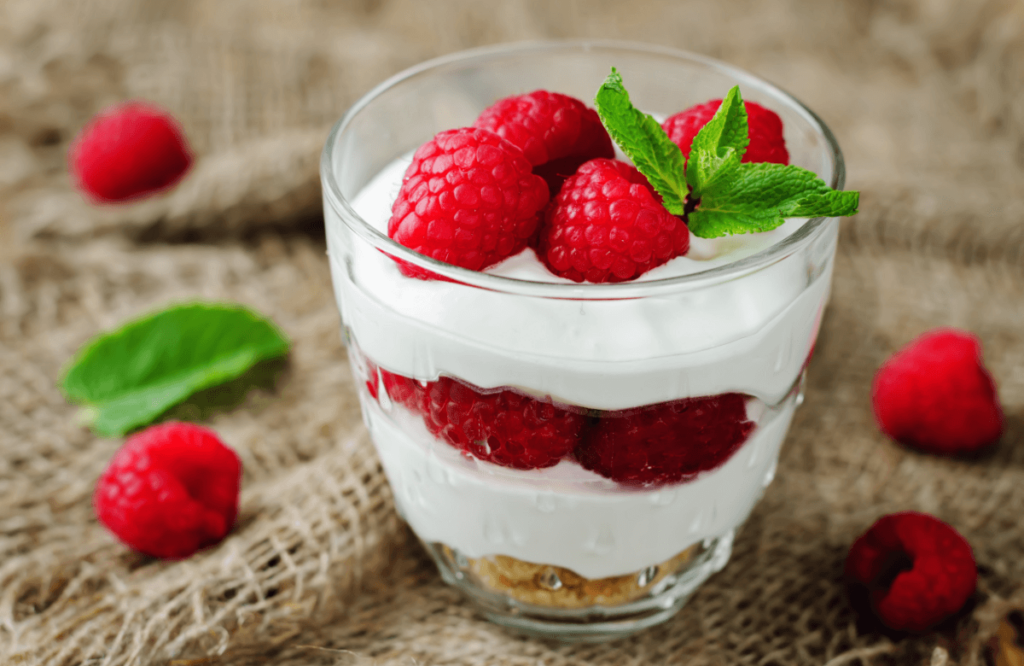
There has been a research specifically on full-fat dairy products and how they can be preventative against obesity. They are saying that both the fat and protein help you to feel satiated and satisfied while having a high DIAAS. So, Greek yogurt can help you prevent cravings for foods that might work against your goals.
One cup of Greek yogurt will give you about 20 grams of protein.
4. Roasted Pumpkin Seeds
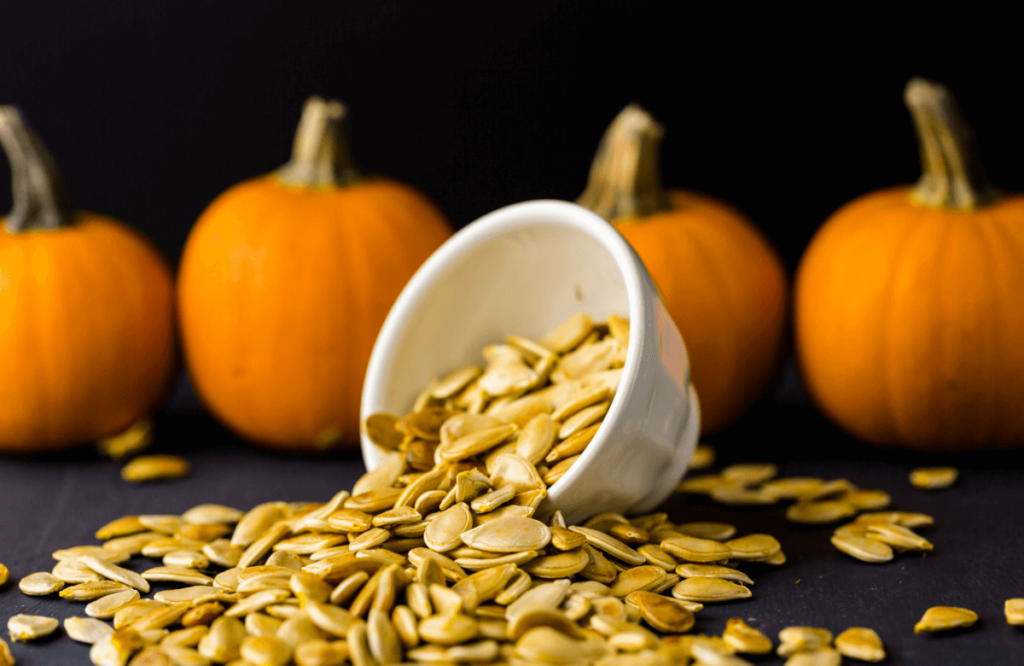
Pumpkin seeds are delicious and highly nutritious. They are a great source of minerals like magnesium, phosphorus, iron, and zinc. Pumpkin seeds are very rich in plant-based protein and fiber. A 100-gram serving of pumpkin seeds provides approximately 19 grams of protein.
5. Scrambled Eggs With Fresh Veggies

Each egg isn’t actually very high in protein and only has about 6 grams. You do need to eat quite a lot of eggs in order to get all your protein needs.
Eggs are great for weight loss goals because they contain both protein and fat. Also, eggs are relatively inexpensive, easy to make, and extremely versatile.
You can eat three eggs and pair them with a little bit of goat cheese to help boost the protein content a little bit more.
There have actually been multiple studies that have found that eggs help people feel more full for longer when they eat eggs for breakfast versus some other types of breakfast foods like cereal.
6. Salmon with Broccoli and Carrots
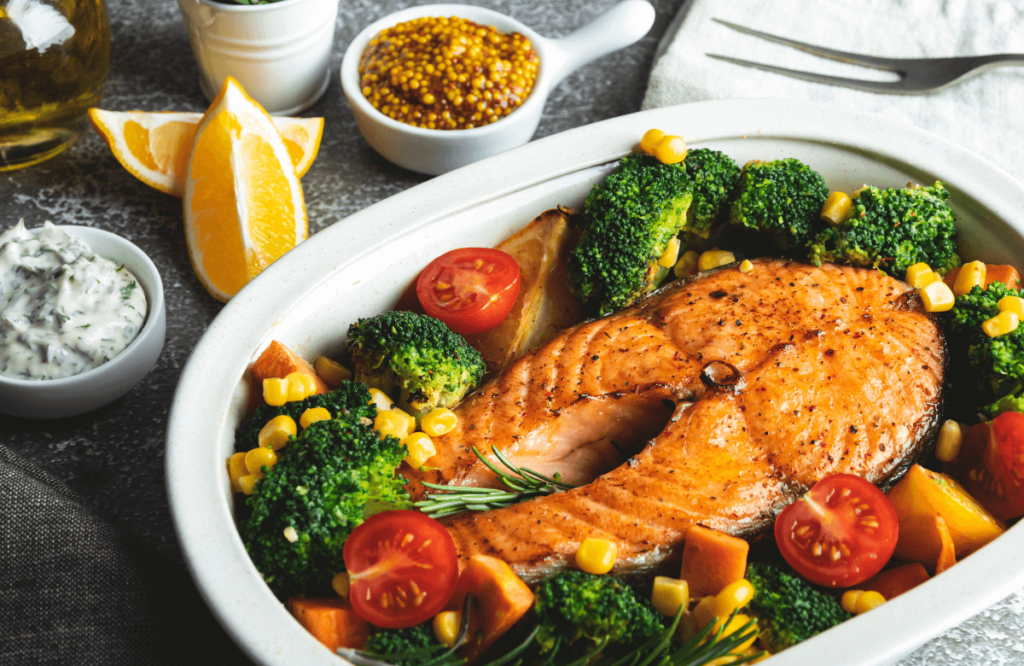
In fact, three ounces of cooked salmon has about 22 grams of protein. It is rich in Omega-3, fatty acids that are anti-inflammatory. It’s also what’s called a high-DIAAS protein which means you readily absorb it and your body can easily use that protein.
7. Mongolian Beef With Garlic Sauce
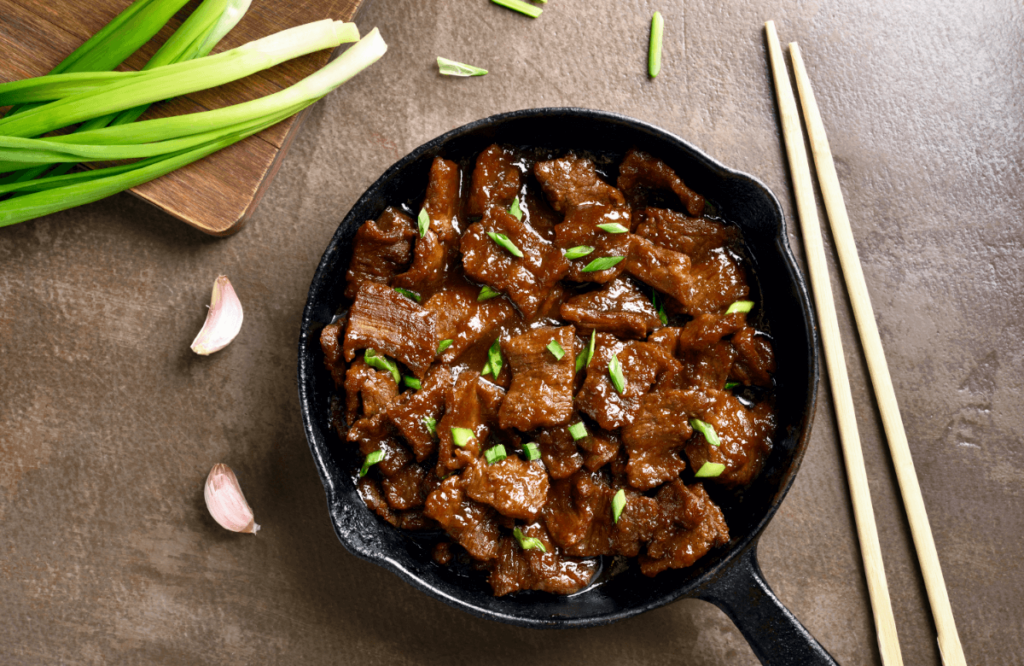
Beef is a high DIAAS protein and has a ton of different nutrients. Three ounces of cooked beef has around 22 grams of protein and it’s so easy to use.
8. Anchovy Pizza
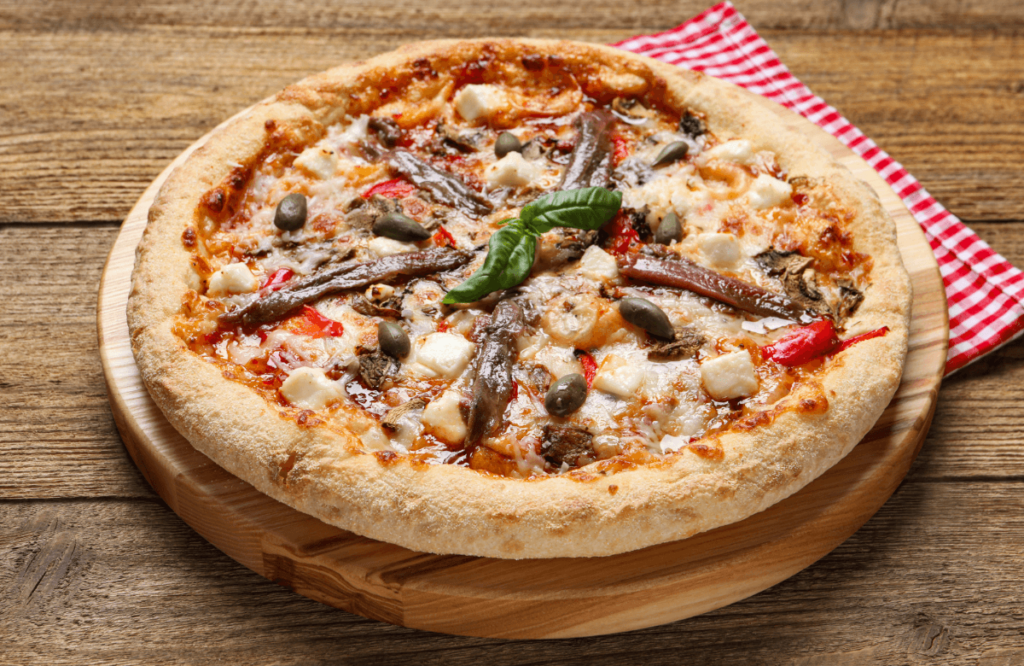
Fatty fish like sardines or anchovies are going to be rich in Omega-3 fats. There’s one meta-analysis where they looked at a bunch of studies and found that fish oil can actually help to reduce abdominal fat specifically.
9. Cottage Cheese Bowls

Cottage cheese is rich in protein. Just about one cup will have anywhere between 24 to 28 grams of protein. It’s also going to be a full-fat dairy product so it has a lot of the same benefits as Greek yogurt.
Just make sure that you check the ingredients and that you’re not getting something that has any added sugar. If the cottage cheese has been fermented, a lot of that isn’t actually true lactose anymore. Cottage cheese requires zero prep and you can bring it with you on the go.
10. Irish Stew
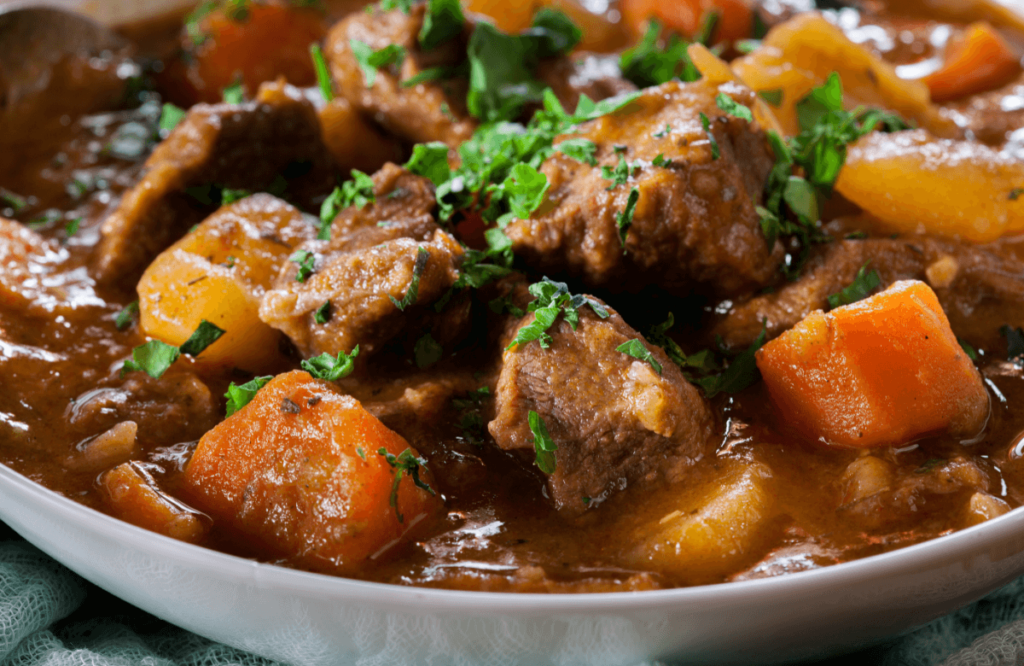
The next one is Irish stew made with pork, sweet potatoes, and carrots.
Pork is a good high quality protein source. About three ounces of cooked pork is going to have roughly 24 grams of complete protein. And it’s going to have a diet score above one.
In fact, all animal-based proteins are going to have a high diet score other than collagen. By the way, collagen is not a complete protein. We wouldn’t recommend using it as a complete protein but it is great for pairing with complete protein sources.
11. Asian Crispy Soy Garlic Tofu
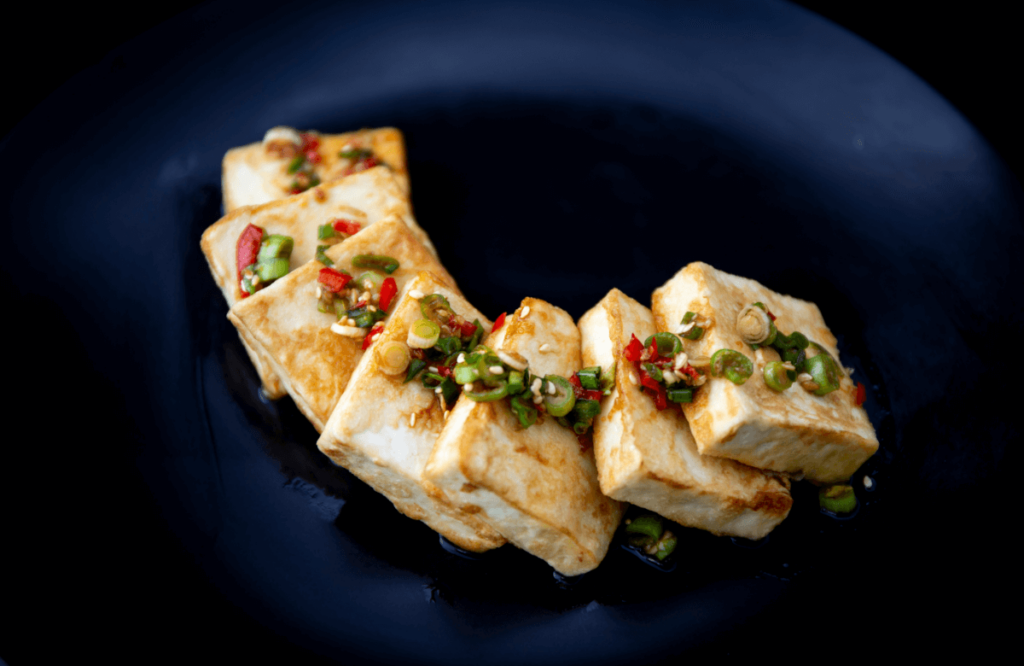
One of the best options for plant-based proteins is going to be fermented soy products. We recommend fermented soy products if you’re going to use soy as a protein source because it helps to break down some of the anti-nutrients of soy.
Soy is one of the highest DIAAS sources of protein that you’ll be able to get from a plant-based source. It has about a 0.9 score. Remember we ideally want a score of one or higher for DIAAS. So, soy is going to be a little low.
By the way, the only plant-based protein that has a score of one is going to be potato protein but there are not a lot of potato protein powders on the market. And if you eat just potatoes, you’re also going to be eating a lot of starch. It’s not helpful for a weight loss goal.
12. Curried Tempeh Salad
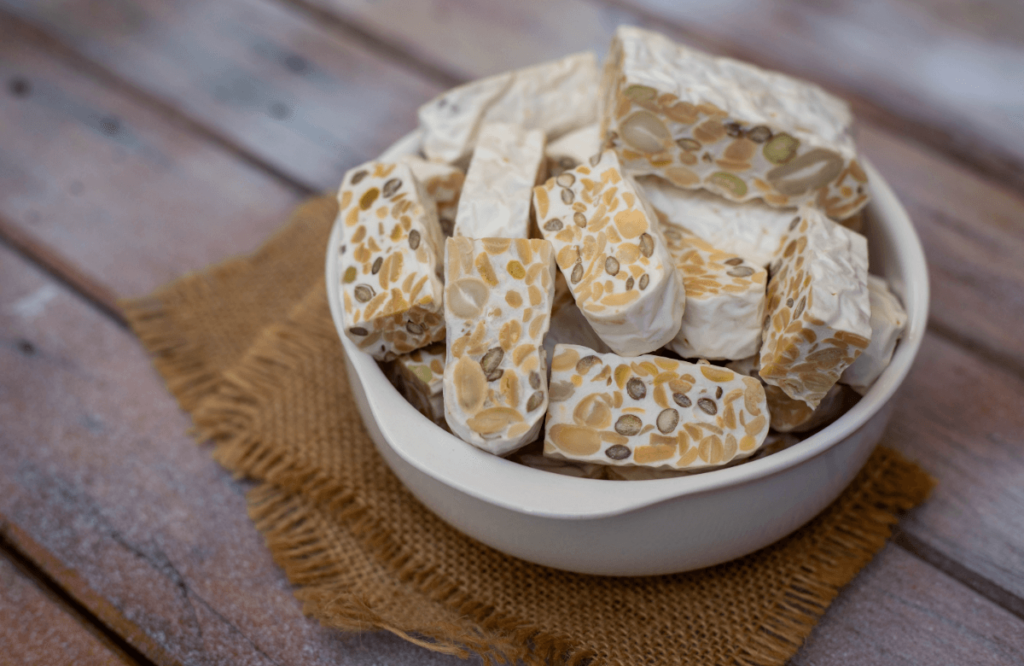
From a plant-based perspective, the highest quality protein source will be tempeh. It is made from fermented soybeans.
There are a lot of easy ways to use tempeh. You can use this traditional Indonesian food in similar ways that you would use meat. For example, you can chop it up and make tempeh tacos or curried tempeh salad.
13. Sardines

Consuming sardines not only do you get protein which is important for body recomposition, you also get the beneficial Omega-3 fats or the fish oil. This protein source is great but you need to know how much of it you need to eat per day. Make sure you calculate how much you need per day.
14. Frittata

Eggs are a good source of protein that is easy to absorb. They are also an excellent source of minerals, vitamins, antioxidants, and healthy fats. Eggs are rich in choline. It’s a nutrient that is especially important during pregnancy and breastfeeding.
Egg white is made up of a protein called albumin. Even though the amount of protein in the egg yolk is relatively low, it contains all the other nutrients of the egg. The specific nutrients in the egg yolk also facilitate the absorption of egg white proteins into the body. Therefore, a person should eat both the egg white and egg yolk to get the maximum benefits.
15. Grilled Chicken Breast

Chicken is high in protein and low in fat making it an excellent choice for people trying to lose weight. A 100-gram serving of chicken breast provides 165 calories, 31 grams of protein, and 3.6 grams of fat with zero carbohydrates. In addition, chicken provides B vitamins and minerals like zinc and selenium.
16. Seasoned Grilled Fish
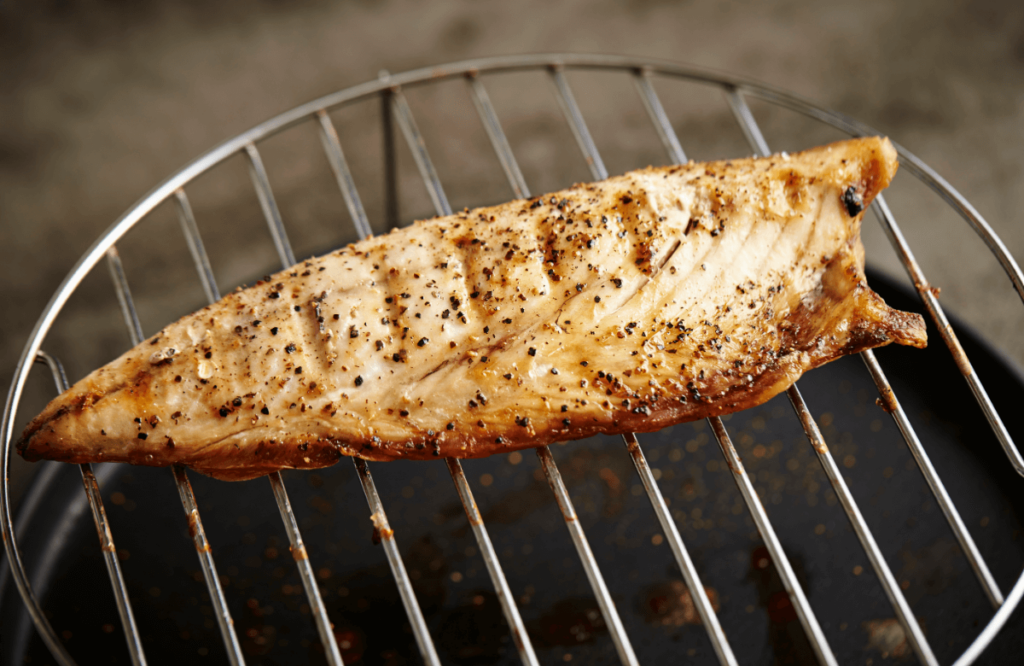
Fish is probably the healthiest food on the planet. It is rich in high-quality protein and many other essential nutrients including B vitamins, vitamin D, iodine, selenium, and omega-3 fatty acids.
Regular consumption of fish is associated with a reduced risk of heart disease and stroke, improved brain health, and a reduced risk for autoimmune diseases.
17. Lean Beef Cheeseburger
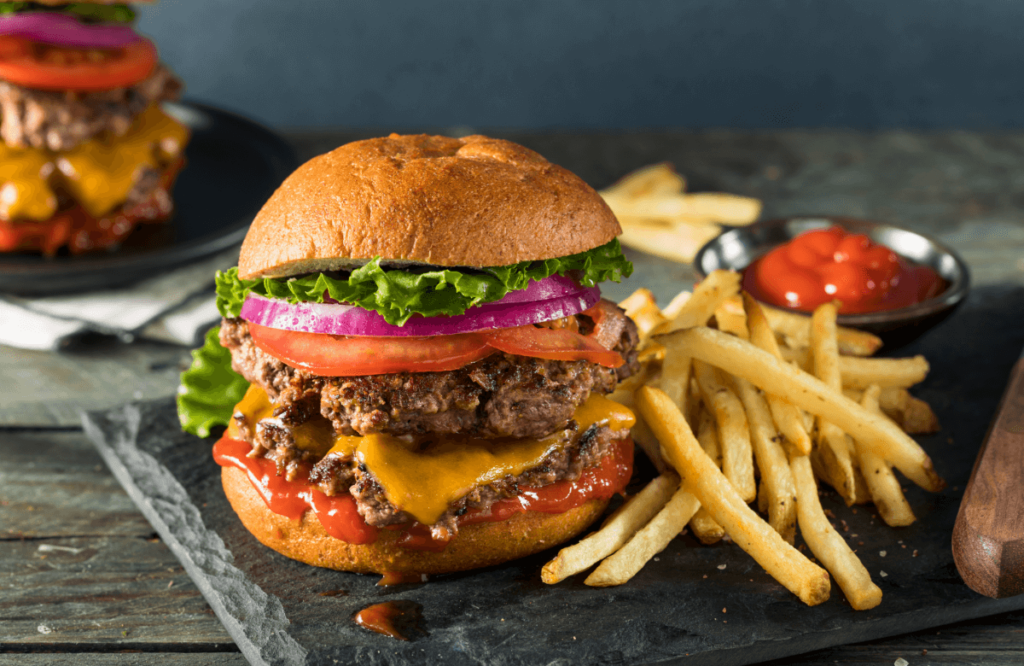
Lean beef is a rich source of protein with 100 grams serving providing around 29 grams of the nutrient. It is also high in iron, zinc, selenium, and vitamin B12. However, it is best to moderate your intake because consuming high amounts of red meat has been linked to a higher risk of developing certain health conditions including colorectal cancer.
18. Lentils

Lentils are probably the richest sources of plant-based protein. They are loaded with other nutrients too including fiber, folate, magnesium, potassium, iron, copper, and manganese. People who regularly consume lentils and other legumes have a lower risk of heart disease and fatty liver disease.
19. Blueberry Protein Pancakes With Caramel Sauce
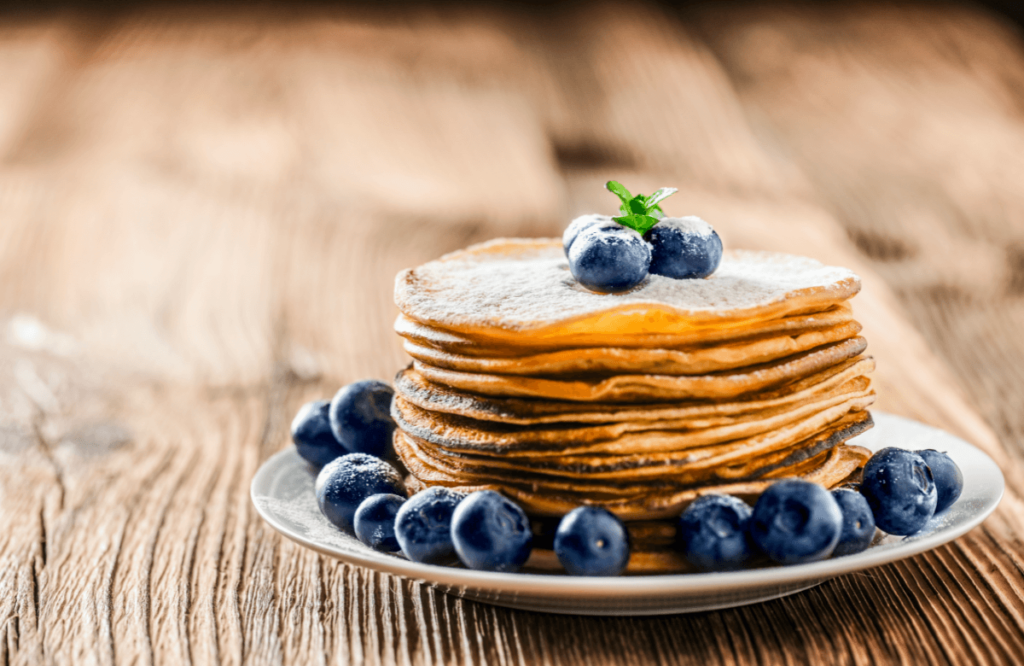
Dairy contains a little of nearly every nutrient that your body needs. It’s a good source of high-quality protein and is high in vitamins and minerals like calcium and phosphorus.
20. Creamy Garlic Seafood Pasta
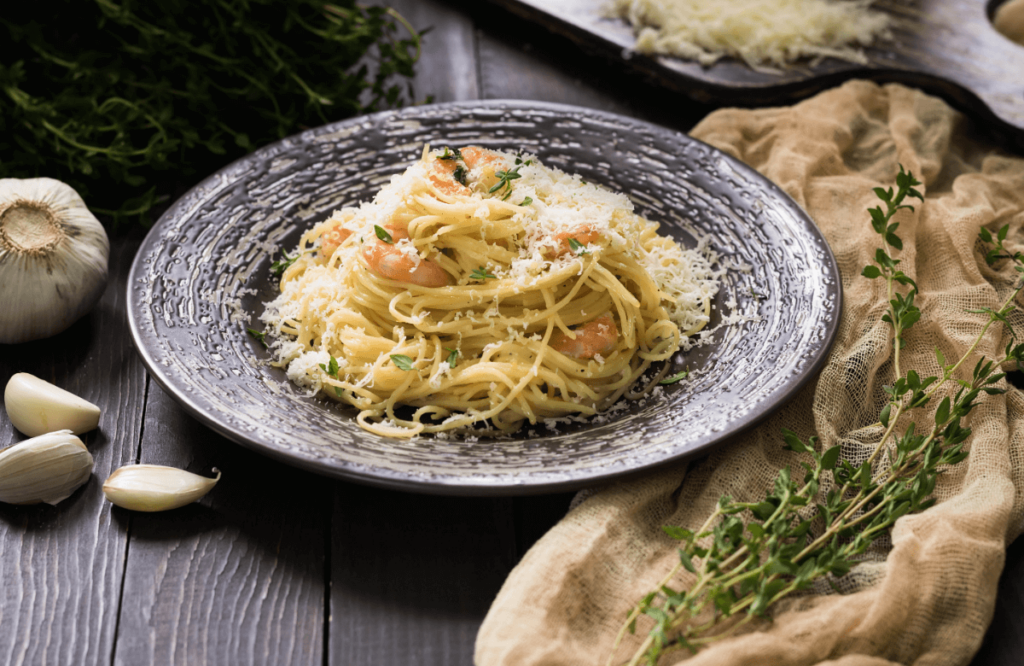
About three ounces of cooked seafood will have around 24 grams of protein. It’s high because generally, most women should eat 15 to 20 grams of protein per meal and most men should eat at least 20 to 30 grams of protein per meal.
What Is a High-Protein Meal?
Protein is one of the most essential tools to help you achieve a weight loss and body recomposition goal. A meal that provides at least 25 grams of protein per serving is considered a high-protein meal.
Benefits of High Protein Meals
Studies show that eating protein-rich dishes improves feelings of fullness and helps you feel satisfied so you will likely end up naturally eating less and losing weight as a result. Also, eating more protein can be great for muscle gain. Some studies suggest that following a high-protein diet can even improve bone health.
High Protein Foods
Examples of foods that provide a lot of protein per calorie are:
- poultry;
- meat (lean cuts of red meat such as sirloin steak and pork tenderloin);
- seafood. If you’re a seafood fan, you’ll be happy to know that all types of fish and shellfish have very high protein percentages;
- eggs and egg whites are also excellent protein-rich foods;
- low-fat Greek yogurt and cottage cheese top the list of dairy products that maximize protein per calorie.
If you follow a plant-based diet, go for tofu, beans, and seitan. Many non-starchy vegetables provide a lot of protein per calorie including broccoli, mushrooms, spinach, and other leafy greens.
As a good rule of thumb, you want to aim for proteins that have a diet score of one or higher. This means that it’s completely absorbed. This can be tricky for plant-based proteins.
Concerns About High-Protein Diets
Are you intrigued by the potential benefits of high-protein meals but worried that eating this way may not be healthy? The truth is that high protein meals are safe for most people. Concerns about eating too much protein are likely unwarranted for most people.
How Much Protein an Adult Should Consume Daily
Most women should aim for about 25 to 35 grams of protein per meal and most men should aim for around 30 to 45 grams of protein per meal. You will get about 30 grams of protein in 3.5 ounces of cooked chicken breast, seafood, or lean meat. And for a visual reference, that’s about the size of a deck of cards.
When Is the Best Time to Consume Protein?
Exact protein timing is not critical if you’re eating enough total protein in an evenly spread manner of 3 to 5 meals per day along with effective resistance training. But if you’re looking for that extra edge, then consuming protein upon rising shortly after a workout and before bed may be beneficial.
How Many Times a Week You Should Meal Prep
You don’t have to do your meals every day. However, for better safety, we recommend scheduling two days per week to prep your delicious meals because most meals are tasty and safe if you store them in the fridge for up to 3-4 days.
Our 10 Tips for Successful Meal Prepping
Do you ever feel like the hardest part of adulting is figuring out what to cook for dinner every single night for the rest of your life? It doesn’t have to be that way. Let’s get into what you need to know before prepping meals.
1. Make Out Your Grocery List
Try to make your grocery list in order as you are walking through the store. This will end up saving you much time and it will also save you from a lot of impulse buys.
2. Variety
Make your grocery list as diverse as possible. Nowadays, there is a large selection of delicious, easy-to-prepare, high-protein recipes that you’ll enjoy. Some of them are keto fried chicken with broccoli and butter and sheet pan teriyaki salmon with vegetables. You may also try ultra-simple snacks like plain non-fat Greek yogurt with berries or chopped apple.
You can boost your protein intake at breakfast by adding egg whites to scrambled eggs or omelets and eating high-protein snacks like zero-sugar jerky. Also, cold cuts or dry-roasted edamame can help you meet your daily protein needs.
3. Double Up
Increasing the quantity of something you’re already cooking is one of the easiest ways to start meal prepping. If you have a recipe that you already know and love, you might want to start by just doubling or tripling that recipe.
4. Eat More High Volume Foods
Remember we’re not just talking about the amount that we’re eating. We’re also talking about what foods we’re eating.
You want to maximize the amount of high-volume foods. These foods are very high in nutrients and low in calories. They’re your fruits, vegetables, lettuce, spinach, and foods that are a little bit higher in water. You literally have a whole world of amazing colorful greens to play with. These foods are awesome because you can eat a lot of them.
5. Meal Prep in Bulk
Cook in bulk. What you can do is roast off your vegetables on a sheet tray and add in some seasonings you like. You can saute off some veggies as well.
Once you have your vegetables done, focus on your proteins. Choose lean proteins like turkey, chicken, or fish. You can shred your chicken and roast it in the oven. It’s a simple cooking technique to get it done and ready to portion.
6. Cool All Your Foods Before Portioning
A good thing to know is to cool all of your ingredients before you start portioning. This is just a great food safety measure and it also keeps your food a little bit fresher.
7. Start Small
The most important place to start is somewhere simple. A lot of people when they start meal prepping tend to take on too much too quickly and they easily get overwhelmed. Maybe they’ll try to plan out and prepare a whole and that is quite a lot for a beginner.
We recommend starting small even just doing two meals for two days. And once it’s completed see how you feel before you move on to something more advanced.
If you’re starting your meal prep journey, remember you don’t have to do everything at once. Start with simple ideas. There’s no point in trying to cook like a master chef if you’re just getting started at this.
8. Start With Recipes You Enjoy
Our next suggestion that goes right along with that is to start with recipes that you already know and love. A good place to start is by writing down all the healthy dinner recipes that you or your family love.
If you have a place where you collect recipes like in a recipe binder or a place on your computer or your phone, that is great. It’s going to be helpful to have them all in one place. Make sure you like a recipe first before adding it to your meal prep rotation.
9. Make It Sustainable
Try out a couple of different styles and see what works best for you and your family. But the most important thing is to make sure that it is sustainable and that you can do it week after week.
10. Plan Your Time Off
Get your recipes in one notebook, check your fridge and freezer, and plan your high-protein dinners based on what you already have.
Do not feel like you need to prep for every single day of the week. If you’re in a busy house and maybe your family likes to eat out every single Wednesday, make sure you write that into your meal plan so that you can give yourself the flexibility to change up your delicious dinners.
Sometimes there might even be days where you just don’t feel like eating what you’ve already prepped. You need to use the freezer for so.
High-Protein Meals: FAQs
What is a good high-protein meal?
A good high-protein meal is one that provides 25-30 grams of protein. Eating more protein can potentially help you lose weight, improve your muscle growth and blood sugar control, and help maintain bone health.
How to get 25 to 30 grams of protein at every meal?
Choose foods with high protein percentages like seafood, lean meats, low-fat dairy eggs, beans, tofu, and vegetables.



